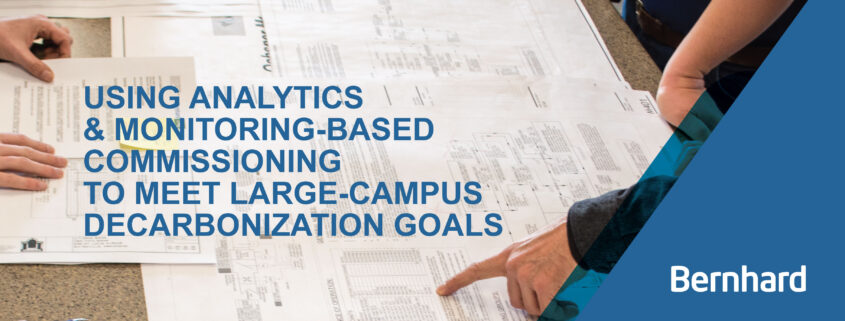Using Monitoring-Based Commissioning to Meet Decarbonization Goals
Finding the right strategy to reach significant decarbonization goals is a complicated task for any organization. That’s especially true for large-campus facilities like hospitals and universities.
With monitoring-based commissioning and next-generation energy analytics platforms like Bernhard Connect®, campus-based facilities have the tools they need to plan for, set and reach important decarbonization targets. By utilizing this software, they can improve operational resiliency, reduce waste, head off issues before they develop into serious problems and realize sizable savings on annual energy spend.
What is monitoring-based commissioning?
Monitoring-based commissioning is a process by which a building’s energy use, efficiency and performance is continually monitored and analyzed using data from remote sensors. These sensors can be installed almost anywhere without major retrofitting, delivering real-time information on HVAC equipment, compressors, internal air temperatures, pumps, chillers, airflow and more.
At Bernhard, our MBCx programs leverage the power of Bernhard Connect®, cloud-based energy analytics platform. Built for automation, ease of use, and agility, Bernhard Connect® features customizable dashboards that can be tailored to prioritize areas of greatest concern or specific goals. It’s the cost-effective energy analytics solution many large-campus facilities have been looking for, allowing them to address their most pressing efficiency challenges and reach decarbonization goals.
By carefully studying this data, facility operators can identify opportunities for improvement, make small tweaks to optimize energy efficiency, prioritize maintenance and ensure that systems are operating as designed.
Utilizing next-generation, cloud-based analytics software, monitoring-based commissioning (MBCx) can often be performed by a handful of employees, working either remotely or from a centralized monitoring center. With automatic fault detection and alerts, issues can be detected and sometimes even fixed or bypassed as they happen, helping keep systems working at optimal efficiency to maximize decarbonization efforts and protect mission-critical services. Collected and archived, the data also allows facilities to adjust their efforts, track progress and develop fact-driven, impactful strategies for operations and future maintenance.
Why choose analytics and MBCx for large-campus facilities?
There are a number of reasons why making progress toward decarbonization is easier for large campuses with MBCx and advanced analytics in place.
Campus-based facilities often include a collection of buildings of varying sizes and roles, built to a variety of construction and environmental standards during the past 50 years or more. These buildings may have different insulation ratings, antiquated windows, lighting, heating, cooling and air management systems, or rely on control systems and infrastructure that might be decades past the point of obsolescence. Many times, wasteful infrastructure is held together just well enough to keep it running, but far below peak efficiency. With so much to handle and parts for aging systems difficult or impossible to come by, large-campus facilities often have a long list of deferred maintenance items.
Because of these factors, it can be difficult to know where to start when trying to develop a meaningful decarbonization strategy and timeline for a large campus. Once the most obvious performance issues have been corrected, decarbonization is often a game of inches, finding efficiencies and slight performance discrepancies that eventually add up to meaningful progress, often during months or years.
By choosing MBCx and advanced energy analytics platforms like Bernhard Connect®, large-campus facility operators can see where improvement needs to be made and which decarbonization strategies would have the most impact. Allowing a small team to monitor potentially hundreds of complex performance indicators in multiple buildings at once, MBCx lets campuses focus their resources and make steady, meaningful progress over time as budgets and workforce allow, while mitigating performance drift that can bleed away decarbonization wins as quickly as they’re made.
In the short-term, O&M teams can see which buildings or deferred maintenance items are the highest hurdles for decarbonization goals, allowing them to prioritize those fixes that can realize the biggest improvements in the shortest amount of time. Long-term, MBCx and archival data allows teams to find hidden inefficiencies and equipment performance issues that might have been too subtle to easily notice before. Meanwhile, automatic, customizable fault detection allows monitoring teams to recognize and act on the warning signs that could indicate a major problem is brewing, even when tracking dozens or hundreds of performance indicators.
Take control and meet your goals
Flying blind on energy use and efficiency is a big part of why many large facilities see their energy costs and carbon footprint grow year after year, often putting even modest decarbonization goals out of reach. With MBCx and advanced analytics platforms like Bernhard Connect®, operators can access the archival data, remote management and real-time system information they need to make ambitious decarbonization goals a reality, usually while finding enough annual energy savings to make MBCx efforts pay for themselves and then some.
Think MBCx, energy analytics and Bernhard Connect® might be the right path for your large-campus decarbonization goals? Bernhard has been helping hospitals and universities decarbonize and find significant energy savings for more than two decades. Our team of experts is ready to put that experience to work for you. Learn more about our work or contact us today to get started.



